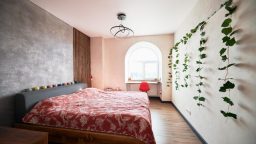Designing a small bedroom can feel like a challenge, especially when you’re trying to make the most of limited space. But with the right approach, a small room can become a cozy, functional, and stylish retreat. The key is to make the space feel larger and more organised, while still ensuring it meets all your needs. Here are some practical tips to help you create the perfect small bedroom that feels spacious and serene.
- Opt for Light Colours
When it comes to small rooms, lighter colours are your best friend. Soft shades of white, beige, or pastel tones help to reflect light, making the space feel bigger and brighter. Lighter colours on the walls, bed linens, and furniture can open up the room and prevent it from feeling cramped or closed off. If you want to add some personality, consider using a pop of colour on accent walls, throw pillows, or bed covers.
If you prefer darker hues, keep them to a single wall or accent pieces like a duvet or rug. This creates depth without overwhelming the space.
- Use Multi-Functional Furniture
In a small bedroom, every piece of furniture needs to serve a purpose. Look for multi-functional furniture that can maximise the space without compromising on comfort or style. For example, a bed with built-in storage underneath can eliminate the need for a bulky dresser. Alternatively, an ottoman that doubles as both a seating area and a storage unit is a great space-saver.
Consider a fold-out desk or a wall-mounted shelf for your workspace. These types of furniture help keep the floor area open, creating the illusion of more space.
- Maximise Vertical Space
When floor space is limited, look up! Maximising vertical space is a smart way to free up room and create the feeling of height. Tall bookshelves, wall-mounted racks, and overhead cabinets can store items you don’t use daily, keeping your bedroom tidy and organised.
Consider installing floating shelves above the bed or on other empty walls to store books, decor, or even plants. You can also add hooks or a pegboard to hang accessories, bags, or hats.
- Choose Sleek, Low-Profile Furniture
Furniture that is too bulky or oversized can overwhelm a small room and make it feel cramped. Instead, opt for sleek, low-profile furniture. A bed with a simple, slim frame or a sofa with thin arms will keep the space feeling airy. When choosing furniture, go for pieces that are minimalistic in design but still offer functionality.
If possible, choose furniture with legs, as this allows light to flow beneath, creating a sense of openness and making the room feel less cluttered.
- Embrace Mirrors
Mirrors are one of the best tricks for making a small room feel larger. They reflect both light and space, making the room feel brighter and more expansive. A large mirror on one wall can create the illusion of depth, while smaller mirrors can be used as stylish decor.
For a modern touch, consider mirrored furniture or decor pieces. Just be mindful not to overdo it, as too many reflective surfaces can make the room feel cluttered.
- Declutter and Keep it Simple
In a small bedroom, clutter can make the space feel even smaller. Be selective about what you keep in the room and make sure everything has a place. Regularly declutter and keep only the essentials. For example, only keep the most-used items on your bedside table—such as a lamp, alarm clock, or a book—and store away other things like jewellery or makeup.
Investing in closed storage options such as drawers or baskets can also help keep things out of sight and maintain a clean, minimalist look.
- Add Vertical or Horizontal Stripes
If you want to visually expand the space, consider using stripes in your decor. Vertical stripes on the walls can make the room appear taller, while horizontal stripes can give the illusion of a wider space. You can incorporate stripes through wallpaper, paint, or even textiles like bed linens or rugs.
Keep the stripes subtle and don’t overdo it—choose a single accent wall or small areas to use stripes, so the design doesn’t overwhelm the room.
- Make Use of Natural Light
Maximise natural light to make your small bedroom feel more open and airy. If you have windows, keep them unobstructed by heavy curtains or bulky furniture. Opt for lightweight, sheer curtains that allow sunlight to filter through while still offering privacy.
In addition to natural light, consider adding soft, ambient lighting, such as wall sconces, pendant lights, or LED strip lights, to brighten up the room in the evening.
- Create a Focal Point
Even in a small bedroom, it’s important to have a focal point—a feature that draws the eye and gives the room personality. The bed is typically the natural focal point, so choose a stylish bed frame or a beautiful headboard that stands out. If you want something a little different, you can create a feature wall behind the bed with wallpaper, a bold paint colour, or a statement piece of art.
This adds interest to the room and ensures that the space feels thoughtfully designed.
- Keep the Floor Clear
A small bedroom should have a clear and open floor plan. Try not to overcrowd the floor with too much furniture or decor. Stick to the essentials and focus on keeping the area around the bed uncluttered. If you need additional seating, consider a slim chair or a floor cushion that can be tucked away when not in use.
By keeping the floor space open, you create a more spacious and inviting atmosphere.
Conclusion
Designing a small bedroom requires thoughtful planning, but with these simple tips, you can transform your space into a comfortable and stylish haven. By choosing light colours, multi-functional furniture, and clever storage solutions, you can make even the smallest room feel open and inviting. The goal is to balance style with functionality, ensuring that your bedroom is not only aesthetically pleasing but also a practical space for rest and relaxation.





